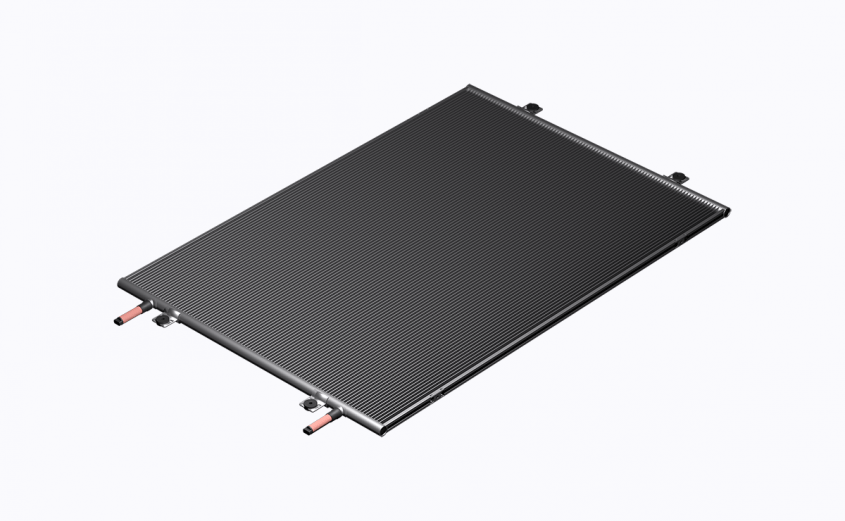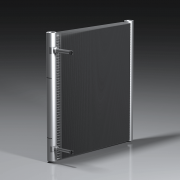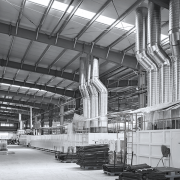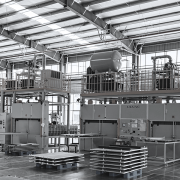Microchannel coils add dimension for cooling systems
by Steven Wand
Although not traditionally used in industrial process applications, microchannel designs may offer advantages over traditional coil technologies in most process cooling applications. Long considered a coil technology primarily used in commercial and residential air-conditioning, microchannel coils are being used by more manufacturers who have discovered how they can improve process cooling applications.
In the air-conditioning industry, the primary reason microchannel coils are used is energy savings. Improvements to the equipment’s efficiency have resulted in as much as a 20 to 40 percent increase in energy efficiency in some applications. Major air-conditioner manufacturers use the all-aluminium microchannel coils in their air-conditioning equipment to achieve these energy efficiency gains.
For process cooling equipment and systems, the advantages may be even greater, and applications are expanding every day to many types of equipment. Some of the more popular applications include process chillers, custom rooftop systems, IT and data center cooling, and harsh challenging applications.
Microchannel Coil Benefits
The microchannel coil concept originated in the automotive industry more than 20 years ago. Modern microchannel technology is more robust than the earlier designs, offering operational, performance and efficiency advantages.
Microchannel coils are constructed of parallel-flow aluminium tubes that are mechanically brazed to heavy aluminium fins. More heat transfer surface is in contact with the air, and high heat transfer rates occur because the refrigerant cools the system and expels waste heat to the air.
As an example, process chillers typically are designed for 50°C condensing temperatures using traditional coils. Using a microchannel strategy, they can be designed for 46 to 48°C using the same 35°C ambient design temperatures. This reduced temperature translates into lower compressor operating pressures, which translates into lower kilowatt usage.
Higher Efficiency vs. Finned Tube Designs
Because the microchannel tubes are flat in design and include multiple channels within each tube, greater heat transfer is possible when compared with more traditional fin/tube designs. The multiple channels provide increased primary surface area, maximizing refrigerant-side heat transfer and reducing air-side pressure drop.
In addition, unlike many copper tube and aluminium fin exchanger designs, microchannels are manufactured via an automated furnace brazing operation that maximizes fin surface contact and increases the heat transfer rate. Traditional coils have fins that are mechanically attached to copper tubes. The fin’s effective contact area is limited and, over time, can decline in performance from continual temperature cycling and galvanic corrosion. These effects can reduce heat transfer efficiency.
Microchannel coils offer other benefits to the process industries as well. The coil face can be up to 30 percent smaller, depending on the process application. This can mean that a microchannel design can provide the same heat removal in two rows compared to up to five rows of traditional coils. The smaller size and aluminium construction also lower the coil weight and reduce the refrigerant charge significantly. The lower weight coils also require fewer structural supports in process machinery while reducing installation labor and time.
Microchannel coils have a robust construction, with thicker tube walls, low flux brazing for reduced corrosion potential and brazed joints. A built-in header/mini-receiver offers full-flow area with low pressure drop. The typical vertical tube design prevents oil entrapment and offers consistent performance over a range of demanding applications.
Where To Consider Microchannel Coils
Among other applications, process chillers can benefit from using microchannel coils. They are designed to circulate a fluid — typically water or a water-glycol solution — through a process application for machine cooling. Supply liquid temperatures typically range between -6 to 20°C, and the chillers can service multiple cooling applications as required. Typical applications include laser cooling, medical cooling, plastics cooling and laboratory uses. Microchannel coils also are finding use in portable chillers because they reduce the overall system size and weight.
Microchannel coils can provide advantages in corrosive and demanding environments. Coastal environments and locations with chemicals or corrosive gases can have detrimental effects on copper tube/aluminium fin (bimetal) coils because the copper tube and aluminium joints promote copper/aluminium galvanic corrosion. The copper causes the aluminium to become a sacrificial anode, ultimately shortening the life of the coil.
All-aluminium microchannel coils are not susceptible to this galvanic combination because they do not utilize copper. This allows them to operate in corrosive environments without degradation in performance. In cases of extremely high corrosive activity, the coils can be supplied with an epoxy coating for additional protection.
Other demanding applications include those with high ambient temperature conditions, and microchannel coils are not hampered by these environments. Because of their high efficiency, they can operate in high ambient environments. In these locations, condenser air temperatures are above 35°C and up to 50°C ambient for R410a refrigeration systems and more than 60°C ambient for R134a and R407c refrigeration systems.
While maintenance is a concern with any coil, the design of the microchannel coil helps minimize damage during maintenance over the life of the coil. All air coils collect dust pillows (bunnies) and debris over time, and they must be cleaned to permit airflow over the coils for efficient heat dissipation. Copper tube/aluminium fins are relatively easy to damage during this maintenance and can be hard to clean without causing damage to the cooling fans. In contrast, microchannel coils can be cleaned with a low-pressure sprayer and soapy detergent without bending the fins. The cooling fins and tubes of microchannel coils are mechanically brazed to the tubes, which provide greater strength.
It is easy to understand why microchannel technology is beginning to be used in process cooling applications. Smaller size, robust design and heat transfer efficiency deliver performance benefits.
Steven Wand is the president and CEO of Alcoil, York, Pa, a leading manufacturer of all-aluminium micro-channel heat exchangers for the air conditioning, refrigeration, ventilation, heating, and industrial process industries. Alcoil specializes in airside condensers, evaporators, heating/cooling coils, oil coolers, and process applications. The company can be reached at +1 717-347-7500 or visit www.alcoil.net
Kaltra Innovativtechnik is an industry leader in the innovation of mission-critical cooling solutions and developer of high efficient cooling equipment. Kaltra is the European representative of Alcoil. Kaltra can be reached at +49 911-715-32021 or visit www.kaltra.com.








